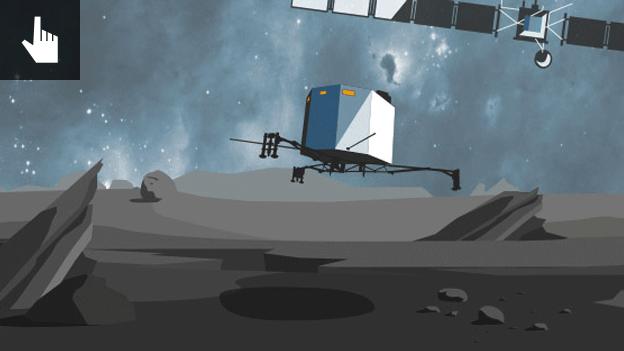Rosetta mission: 'Looking good' for comet landing bid
- Published

Navigators must design a perfect delivery manoeuvre so that Philae's chances of success are maximised
European Space Agency officials say all looks good ahead of this week's historic bid to land on a comet.
Esa's Rosetta satellite will despatch its piggybacked Philae probe to the surface of the "ice mountain" known as 67P on Wednesday.
Controllers report both mothership and descent robot to be in excellent shape.
The landing commands on Philae have already been loaded, and an instruction was sent up on Monday evening to switch on and warm the probe.
The intention now is to leave it in an active state, ready for the separation. This is timed to occur at 08:35 GMT on Wednesday.
Touchdown should follow about seven hours later, with a confirmation signal expected back on Earth around 16:00 GMT.
But before the mission can get to this milestone, Rosetta must be primed to make its delivery run.
The satellite is currently moving on a long, slow arc around 67P at a height of about 30km.
At a predetermined time on Wednesday morning, it has to turn and head in towards the comet, releasing Philae on the path that will take it down to the targeted landing zone.
Executing this pre-delivery manoeuvre with high precision is the one really big issue vexing controllers.
They know their calculations for the thruster burn must be spot on. They know also that they will have very little time to assess its performance before giving the final "go" for separation.
"The point of separation is fixed in time, in space, velocity and attitude; and we have to reach exactly that point," explained Esa flight director Andrea Accomazzo.
"So, wherever Rosetta is, we have to design a manoeuvre to reach that point."
Navigation specialists here at Esa's operations centre in Darmstadt, Germany, will examine the present flight path of Rosetta on Tuesday afternoon.
They will then have the detailed information they require to implement this critical delivery dash.
But if any of the parameters are out by even a small degree, the errors will expand as Philae heads downwards.
Already, the landing zone, which is on the head of the rubber-duck-shaped comet, is considered extremely challenging.
It contains some very uneven terrain, with cliffs, boulders and a number of steep slopes.
Controllers will not want to make the probe's task even more difficult by sending it off-track.
Philae should touch the surface with a velocity of about 1 metre per second.
Foot screws and harpoons will hopefully lock it down. A small gas thruster will push the probe into the surface to give these mechanisms time to work.
"It will take a few minutes to really analyse and fully understand that, yes, we are landed; yes, the harpoons are fired and safely anchored," Stephan Ulamec from the German space agency told BBC News.
Whatever happens on Wednesday, the scope of the Rosetta mission will go through a major gear change, according to Esa project scientist Matt Taylor.
Since the satellite arrived at the comet in August, much of its focus has been on finding a suitable landing location for Philae.
With the landing now all set to occur, the emphasis can shift more towards the scientific study of the Comet 67P.
"Up until now, we have been doing science on the side, doing characterisation of the comet to enable landing site decisions.
"From this week onwards is when we start the main phase of this mission, in my view. It's all go now - so, stay tuned," Dr Taylor said.
Even if Philae fails in its landing attempt, the Rosetta mothership will continue its remote observations of 67P through all of next year.

Rosetta officials deliver Monday's media briefing at mission control, Darmstadt

Rosetta is the first mission to get up close and properly characterise a comet
Jonathan.Amos-INTERNET@bbc.co.uk and follow me on Twitter: @BBCAmos, external
- Published7 November 2014
- Published17 June 2015

- Published4 November 2014

- Published24 October 2014
